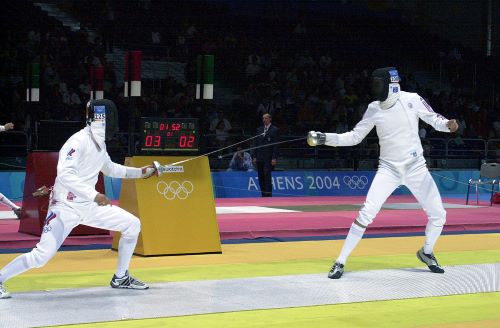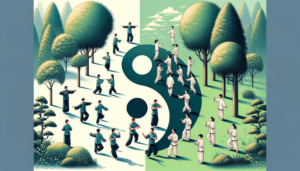
Are you wondering if fencing is a martial art?
In this article, we’ll look at the 4 reasons why fencing is a martial art.
Contents
Is Fencing a Martial Art?
Yes, fencing is a martial art – a weapon-based martial art. Fencing fits under the various definitions of martial arts as it has a codified system of combat practiced for self-defense and sports competition, and it’s also a tradition of combat with a long history and inclusion in many cultures.
In order to fully answer the question, ‘is fencing a martial art?’, let’s examine the 4 main reasons why fencing is a martial art.
1. Fencing Fits the Definition of a Martial Art
First and foremost, fencing is a martial art because it fits the definition of martial art. So, what is a martial art?
The most realistic and encompassing definition of martial art comes from Wikipedia.
‘Martial arts are codified systems and traditions of combat practiced for a number of reasons such as self-defense; military and law enforcement applications; competition; physical, mental, and spiritual development; entertainment; and the preservation of a nation’s intangible cultural heritage.’
Why a particular martial art is practiced isn’t important. Fencing is a codified system of combat practiced for many reasons, and it’s also a tradition of combat because of its long history and inclusion in many cultures.
Merriam-webster defines martial art as ‘any of several arts of combat and self-defense (such as karate and judo) that are widely practiced as sport.
The Collins dictionary defines martial art as a ‘method of fighting, often without weapons, that come from the Far East, for example kung fu, karate, or judo.’
While there are many slightly varying definitions of what a martial art is, common among all is that martial art is a method of fighting, an art of combat, or a codified system of combat. Therefore, fencing is a martial art without a doubt.
Let’s explore this further.
2. Fencing Is One of the Oldest Forms of Fighting and Has a Long History and Culture
Fencing originated from swordplay in 1190 BCE, evidenced by a painting on the wall of an Egyptian tomb. This makes fencing one of the oldest martial arts still in existence, alongside wrestling and boxing.
Sword fighting continued and is recognized for its systematic use in Roman gladiator contests between 264 BC and 404 AD.
This progressed into dueling in the Middle Ages (5th to 15th centuries), which was an organized swordfight used to lawfully settle disputes between two people – often leading to death or serious injury.
Dueling continued in some countries until the late 19th century, while the last recorded duel was in 1967.
Fencing has been a sport-based martial art since 1896 when the Amateur Gymnastic and Fencing Association introduced official regulations for fencing.
Also in 1896, fencing became the first and only martial art introduced at the first modern Olympic Games, the 1896 Athens Olympics.
3. Fencing Has a Codified System of Fighting Techniques
In the 15th century, sword fighting became a form of military training and the first fencing guilds were opened, such as the Marxbrueder of Frankfurt in 1478.
With the emergence of guilds, civilians were learning how to fence and were openly carrying weapons in Europe as a form of self-defense and as a way to solve disputes.
In this way, it’s possible to say that fencing as a martial art started in the 15th century because of how it was becoming a codified system of combat in France, Germany, Italy, and England. This ties in with the Merriam-webster dictionary which claims the words fence and fencing were first used in the 14th century.
While fencing had become codified in the 15th century through guilds teaching civilians (mostly upper class) and as military training, it wasn’t until the mid-18th century that fencing shifted towards a sport-based martial art.
This happened because of Domenico Angelo, who founded Angelo’s School of Arms in 1763, a fencing academy in Soho, London. He was the first fencing master to promote fencing’s fitness and sporting benefits, rather than a martial art for dueling and killing – in his book The School of Fencing (1763).
The book also included fencing tactics, techniques, and positions which helped develop the framework for correct posture and footwork later used in modern Olympic fencing from 1896 onwards.
4. Other Reasons Fencing Is a Martial Art
While less important than the above three reasons, fencing is a martial art because:
- Fencers spar to practice like other martial arts.
- Fencing is 1 of only 5 martial arts currently in the Olympic Games.
- Fencing demands and improves speed, anticipation, reflexes, eye-hand coordination, and great mental strength. All of these practiced skills can also improve hand-to-hand combat.
- Fencing like many martial arts can be used as exercise and spiritual and mental enhancement.
- Fencing was used to settle disputes in which many people died as a result.
- Fencing became military training around the world until the emergence of guns rendered sword fighting less effective.
- If someone learns how to fence today, they’re well-equipped to defend themselves in self-defense situations using weapons.
The Bottom Line
So, ‘Is fencing a martial art?’
Yes, fencing is a martial art. Both the classical form of fencing (used for duels and military training) and the modern sport-based fencing can be considered martial arts because they’re both codified systems of combat practiced for either self-defense or sports competition.




